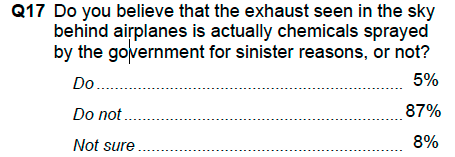skephu
Senior Member.
A new paper with the above title has been published in the journal "Palgrave Communications" by Dustin Tingley and Gernot Wagner.
https://www.nature.com/articles/s41599-017-0014-3
Abstract:
https://www.nature.com/articles/s41599-017-0014-3
Abstract:
The conclusion:Discourse on social media of solar geoengineering has been rapidly increasing over the past decade, in line with increased attention by the scientific community and low but increasing awareness among the general public. The topic has also found increased attention online. But unlike scientific discourse, a majority of online discussion focuses on the so-called chemtrails conspiracy theory, the widely debunked idea that airplanes are spraying a toxic mix of chemicals through contrails, with supposed goals ranging from weather to mind control. This paper presents the results of a nationally representative 1000-subject poll part of the 36,000-subject 2016 Cooperative Congressional Election Study (CCES), and an analysis of the universe of social media mentions of geoengineering. The former shows ~ 10% of Americans declaring the chemtrails conspiracy as “completely” and a further ~ 20–30% as “somewhat” true, with no apparent difference by party affiliation or strength of partisanship. Conspiratorial views have accounted for ~ 60% of geoengineering discourse on social media over the past decade. Of that, Twitter has accounted for >90%, compared to ~ 75% of total geoengineering mentions. Further affinity analysis reveals a broad online community of conspiracy. Anonymity of social media appears to help its spread, so does the general ease of spreading unverified or outright false information. Online behavior has important real-world reverberations, with implications for climate science communication and policy.
Chemtrails are not real. Belief in the chemtrails conspiracy is. Between ~ 30 and ~ 40% of the general US public appear to subscribe to versions of the conspiracy theory, numbers only topped by the large fraction (~ 60%) of social media discourse, more on Twitter, focused on the topic. That renders rational conversations around solar geoengineering and its potential role in climate policy even more difficult than it would be absent the chemtrails conspiracy (Burns et al., 2016). It also shows some of the broader implications of this online community of conspiracy with implications well beyond climate policy.


